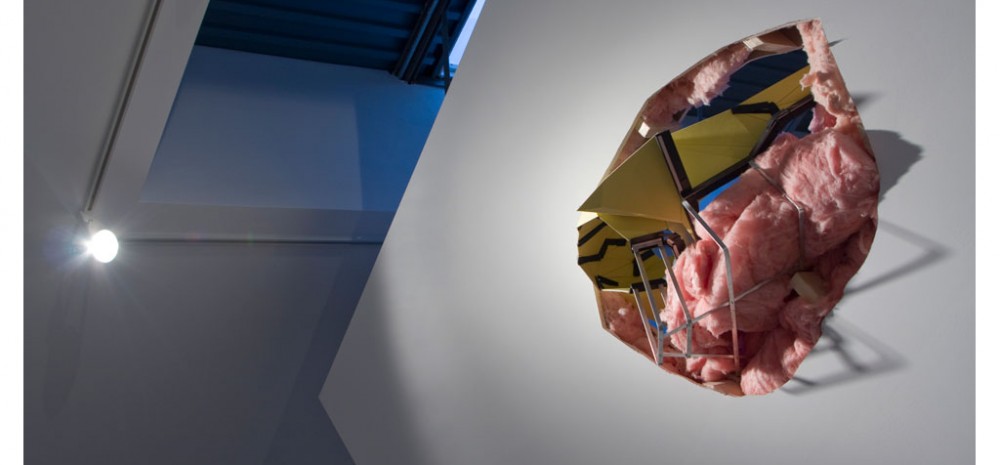Born in 1967 in Kirn, Germany
Lives and works in Vienna
Ricarda Denzer
restore, 2008
This work is inspired in part by a conversation I had with the artist Nora Naranjo Morse, in which I learned that Native Americans believe that those who pass away will come back to earth as rain.
“The formal concept behind Denzer’s work is based on a documentary approach audio and film tapes are recorded, people are interviewed, texts read, and topics researched in an obsessive act of collecting  to form the basis for deliberation. The audio and video tapes are collaged, and arranged according to an associative logic where fact and fiction overlap to produce a new, condensed form of narrative.†(Patricia Grzonka, Lucky Number Seven catalogue text, Santa Fe, 2008)
The visitor enters a plain white empty space. The space is the only room in the exhibition with natural lighting  daylight coming in from the skylights above. Voices of different people are moving through the dazzling whiteness of the space, like the visitors themselves. Arriving, entering, passing through, dwelling on and leaving again, a pattern of spoken words appear like rain.
“In Western society it’s a bit like looking in, and making native art is looking out from.†(Bruce Burnstein, Director of Southwestern Association for Indian Arts, Nora Naranjo Morse)
A yellow, spaceship-like model, the linespacer, cuts a gap into the middle wall of the daylight space. Denzer has based her contribution for the community on a miniaturization of her stage-like setting 10m2 tragbar (2006), a mobile recording studio that the artist originally conceived in collaboration with the Austrian architects Heinz Machat and heiKE/NZ for a series of interviews. All of the elements of the studio  a translation booth and architectural elements  are easily assembled and dismantled. Denzer’s interest in all forms of transmissive processes is manifested in this work, for example, linguistic translations, or cultural transfers, and their impact on differently codified social standards.†(Patricia Grzonka, Lucky Number Seven catalogue text, Santa Fe, 2008)
Following another path through the exhibition, the visitor reaches a hallway above the skylight room. At its end there is a plasma screen showing a video work. The linespacer serves as a filmsetting in the desert of New Mexico. The film technique shot-reverse-shot is “used to establish a dialogue situation, such as looking into and looking out from, the insiders and the outsiders, the gaze and the landscape, we and they, rich and poor, arts and crafts, Santa Fe and Vienna, import and export, donating and collecting. (Ricarda Denzer, Vienna, April 2008)
Ricarda’s work is located in the enclave between Galleries 1 and 2. Her work is accessible on the ground level and also viewable from the upstairs ramp.
Ricarda Denzer engages with the aspects of film and architecture to explore notions of power and the forms it takes within the public and private spheres. Her work revolves around language, particularly the spoken word, which often serves as the focus of her investigations into the relationships between author and subject. Sound is an integral component to verbal communication, and Denzer examines the tonal shifts, pauses, and utterances that often go unnoticed during the simple act of speaking. For Denzer, language, like paint or clay, is an artistic material that can be manipulated into different forms whose intrinsic narrative value is by its very nature encoded with multiple meanings.
How are stories created, and how can these dialogues be fixed in the moment of their creation? These questions are the starting points for Denzer’s audio-visual productions. The emptiness of a place may trigger a reading of the absent that gradually mutates into a production of meaning. By drawing attention to secondary scenes that appear banal to everyday eyes, Denzer transforms these anonymous spaces into sites imbued with the potential for new narratives. Removing all barriers for distraction, we focus our gaze on the non-visible.
La crote du chou – Das Saure vom Kraut (2007) is a multipart audio-visual piece based on a conversation with Namrata Bali, treasurer of the Self Employed Women’s Association. The core issues of SEWA are to define what it means to be a woman and to be a working woman, to organize the unorganized, and to have one voice. Beginning with this interview, in an associative, non-linear narrative form, Denzer deals with existential domains of labor, of being, and acting. What does it mean to earn money, to work in order to organize oneself, or to lose track? How do the act of speaking and the system of language work as an instrument for not accepting the world as it is? How can protest, private language, and being visible in public be applied as practices of resistance which are not wage and profit-oriented?
Through these processes of participation, Denzer engages the viewer in dialogues about history, migration, and cultural identity in subtle ways. Projection, intuition, fiction, and fact overlap one another in the monologues delivered by the viewers who through the act of speaking increasingly become readers and authors of themselves and their own frames of life.
Barbara Holub
